Calculation of hoods for the kitchen: how to calculate the power of the hood
The atmosphere of the house is more or less protected from the dusty and gassed street, but is defenseless against air pollutants produced by the kitchen. Agree that there is very little open window when cooking.
An exhaust hood over the stove and a ventilation duct with a “outside” outlet are required, but before that, a hood hood for the kitchen should be calculated to select equipment with suitable capacity. But how to do this in order not to attract specialists?
We will try to tell you - in this material the order of calculation is described in detail, formulas and specific examples of calculations are given. Visual photos and useful video tips on choosing and installing hoods are also selected.
Following the recommendations, you can independently calculate the required power of the exhaust device, which will timely and fully remove the exhaust air.
The content of the article:
How is the hood different from ventilation?
In modern apartments above the stove is placed exhaust hood, better known as a range hood. Many homeowners are convinced that this air bag is responsible for the ventilation of the kitchen.
Therefore, they, with a clear conscience, start the ventilation duct pipe from the hood into the ventilation hole designed and built by the designers of the high-rise building.
What happens if regular ventilation in the kitchen is blocked by an air duct from an exhaust hood? The air exchange rate in the apartment will decrease sharply.
Kitchen hood installers and sellers of kitchen hoods usually state the opposite. They will say: this technique will significantly improve the quality of air supply at home, because it has a powerful ventilation system.
However, the power of the stove hood is in no way connected with ventilation. The reason is the air exchange in the apartments of most residential high-rise buildings, especially those built before 2000, were designed with the expectation of supply and exhaust ventilation.
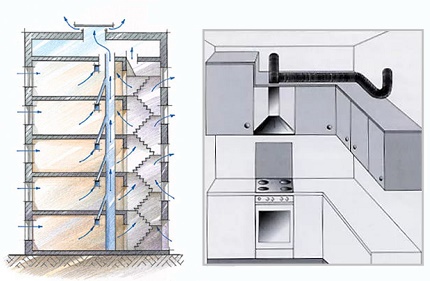
Street air entered through the slots of the window frames and the front door. A channels ventilation in the kitchen, in a bathroom and a bathroom were used for a conclusion of "stale" air. It would seem - what is it?
Hood in the kitchen - for drawing air. So why it is impossible to “stick” an air duct from an exhaust hood? The point here is air performance.
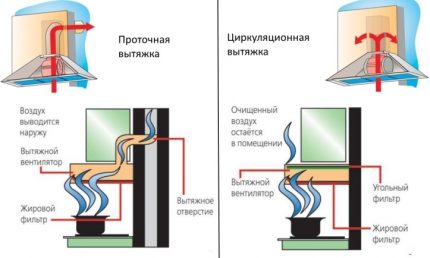
Duct ducts in residential apartment buildings are designed for a specific load. In general, the throughputs of any communications are carefully calculated at the design stage.
And in ideal conditions (clean walls of the ventilation duct, the absence of interference at the inlet-outlet, etc.), the natural ventilation performance in the apartment of a high-rise building will be 160-180 m3/ h
You may also be interested in the information on the normative air velocity in the ducts, considered in this article.
Kitchen hood feature
For models of exhaust umbrellas, the power is significantly higher - 200-1100 m3/ h Such power is needed to draw into the duct the volatile contaminants generated during cooking.
However, sellers of hoods declare another reason for choosing the power of the hood - the need for frequent air exchange in the kitchen.
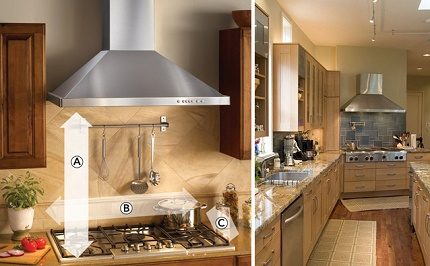
The standards of mechanical ventilation do state 10-12 times the change of air in the volume of the served premises (SNiP 41-01-2003).
But the hood hood located above the stove does not perform the function of “ventilation of the room”, because it is not capable.
Needs updating (replacement) air accumulates at the ceiling. An exhaust umbrella is not capable of sucking it into the ventilation duct - its bell is not set high enough. And the air flow during the discharge and injection behaves differently.
An electromechanical installation draws air from a distance not exceeding the diameter of the suction bell. Those. at 400 mm the width of the hood umbrella, air will be drawn into it, located no further than 400 mm from the bell.
Meanwhile, the airflow is released over a distance exceeding 15 diameters of the exhaust opening.
A simple “home” example: a household fan on. On its reverse side, the air movement is barely noticeable, but on the front side there is a powerful air stream. By the way, the vacuum cleaner works on the absorption of dust only at a minimum distance from the carpet.
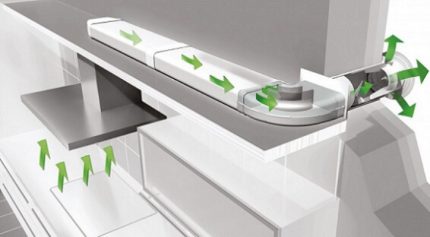
An exhaust hood over the stove performs the only task - removing air from the surface of the hob.
Of course, in return for the injected air, another portion will come to the stove from the window, open door to the next room, etc. But a complete change in air volume in the kitchen will not happen.
If the smells of cooked food rise to the ceiling, they will not participate in the mixing and are difficult to remove.
For this reason, the manual for exhaust hoods contains the following conditions placing hoods and work: 600 mm from the electric stove; 750 mm from the gas stove; Avoid air currents (drafts) during the operation of the hood, otherwise smells will spread throughout the room.
The cooker hood does not provide air change in the kitchen. When choosing her model, the air volume of the room does not matter. The relationship between the size of the kitchen and the power of the exhaust hood was invented by sellers of kitchen appliances.
How to calculate the required hood power? Of course, based on the performance of the stove.
When performing calculations for the selection of a cooker hood, the following factors should be considered:
The procedure for calculating the exhaust hood
To calculate the required hood performance, you need to know the parameters of the stove.
In the calculation below, as an example, the characteristics of the gas stove of the Slovenian manufacturer Gorenje (model GI633E35WKB) were used. Note that the brand and model of the plate are chosen arbitrarily.
You may also find useful information on how to hang the hood over the gas stoveconsidered in our other article.

The calculations made below are performed according to the method R NP "ABOK" 7.3-2007. Despite the “industrial” purpose of this method (ventilation of hot food shops), its formulas can be used to calculate the parameters of household hoods for the kitchen.
When cooking, the stove generates heat that needs to be recycled (exhausted). The heat dissipation of the plate forms convection air flows above it, which simplifies the operation of the exhaust hood. But it is impossible to completely eliminate air pollution that occurs over the stove, relying only on convection.
Stage # 1 - calculation of the total heat output
Volatile particles formed during cooking are delivered to the exhaust hood or panel by convection airflow. It is the heat developed by the burners that provides air volumes for elimination. Therefore, it is required to calculate their total thermal power.
To determine it, use the formula:
QT= q1+ q2+ q3+ q4,
Here q - passport thermal power of one burner, kW.
The cooker model in question has four gas burners on the surface, their thermal capacities must be summed up.
We consider: QT= 1.9 + 1.9 + 1.0 + 3.5 = 8.3 kW. The obtained value of the thermal power is true when cooking at all burners at the same time, which is rare.
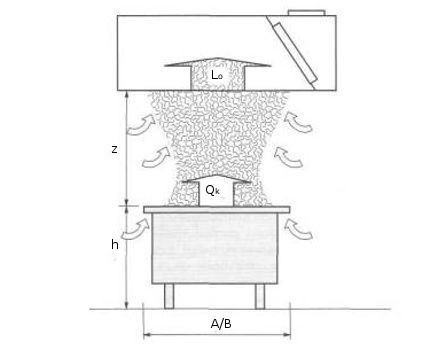
In principle, it is possible to take into account the heat release of only three burners with the highest heat output. But let's leave it just in case.
To calculate the exhaust power, you must determine the air flow (Lo) according to the parameters of the stove. However, the air flow rate formula requires the calculation of intermediate parameters - the hydraulic diameter of the plate surface (D), air flow rate in convective flow (Lki) and volumetric flow rate of combustion products (Lri).
Also, the coefficients developed by the specialists of NP ABOK are used in the calculation process. The values of the coefficients are selected according to the parameters suitable for household stoves.
Stage # 2 - calculation of hydraulic diameter and flow
Let us calculate the hydraulic diameter and convective air flow. The first parameter is determined by the formula:
D = 2 * A * B / (A + B),
Where:
- A - the width of the stove, m;
- B - kitchen stove length, m.
We substitute the values of the width and length of the model of the gas stove selected for the approximate calculation: D = 2 * 0.6 * 0.6 / (0.6 + 0.6) = 0.6 m.

To determine the volume of convective flow, you must first find out the proportion of convective heat generation of our stove. It is calculated using the formula:
Qk= QT* KI AM* KK,
Where:
- QT - plate power determined above, kW;
- KI AM - the share of the apparent heat from the thermal power of the kitchen equipment. For a domestic cooker, a value of 250 W / kW is assumed;
- KK - the proportion of convective heat in relation to the apparent heat of the kitchen equipment. The value is 0.5.
Substitute the numerical data in the formula, consider: Qk= 8.3 * 250 * 0.5 = 1037.5 W. We move on and proceed to the calculation of convective air flow.
The formula is as follows:
Lki= k * Qk1/3* (z + 1.7 * D)5/3* r,
Where:
- k - coefficient obtained by experts of NP "ABOK" experimentally. It is taken equal to 5 · 10-3;
- Qk - the proportion of convective heat dissipation calculated above, W;
- z - distance from the surface of the stove to the exhaust hood, m. The minimum distance for placing the hood vertically from the gas stove is 0.75 m;
- D - hydraulic diameter of the tile surface, m. The formula for its calculation and the calculation example are presented above;
- r - correction factor, the value of which depends on the conditions for placing the hood (see image of the table above). In our example, the position of the exhaust umbrella “against the wall” will be chosen, with a coefficient value of 0.75 (due to the conditional “proximity” of cabinet furniture in the neighborhood, which is usually the case for kitchens).
We determine the convective flow rate, substituting numerical data in the formula:
Lki=5·10-3*1037,51/3*(0,75+1,7*0,6)5/3* 0.75 = 0.061 m3/with
According to the results of calculations, the air flow as a result of convection over the stove is quite intense. Given these data, it turns out to choose the fair power of the exhaust system.
Stage # 3 - calculation of the exhaust hood power
The electric stove in the process of cooking does not emit combustion products, because heating of rings occurs without open burning - thanks to ten. But gas burners produce combustion products and the hood will have to be removed.
The formula for calculating the volumetric flow rate for methane combustion products:
Lri=3,75*10-7* QT,
Here QT - Installed capacity of the stove, kW. This parameter was previously found by us.
Enter its data in the formula and get: Lri=3,75*10-7*8,3= 3,1125*10-6.
From the example it is clear that the value of the volumetric flow rate of the combustion products of a household gas stove is small.Therefore, when determining the parameters of a kitchen hood, it is permissible to neglect it.

So, it is the turn to calculate the air flow for our stove. This is the determining parameter when choosing an exhaust hood.
The formula for calculating it:
Lo= Lki+ Lri,
Where:
- Lki - the value of the air flow from the convective flow rising above the stove, m3/with;
- Lri - data on the volumetric flow rate of natural gas combustion products in the burners of the stove, m3/with.
It remains to enter data and calculate the required air flow with rounding the result to three decimal places: Lo=0,061+3,1125*10-6= 0.061 m3/with. We found the air flow in cubic meters per second, but cubic meters per hour (L) are needed to select the model of the exhaust hood.
For translation m3/ s in m3/ h should multiply the resulting air flow (Lo) by the number of seconds in one hour and by the hydraulic diameter of the plate (D) / L = 0.061 * 3600 * 0.6 = 131.76 m3/ h.
Thus, the maximum maximum power of the exhaust hood for the Gorenje gas stove model shown in the example, with rounding "in reserve", will be 150 m3/ h Big power is simply not needed - a waste of energy.
Why is the powerful hood “not pulling”?
First, check the condition of the ventilation channel in the exhaust device itself, remove and rinse (or replace) the filters - fatty and, perhaps coalthat depends on the model of the hood. The best methods for cleaning kitchen hoods from fat are considered in this article.
You also need to make sure that the ventilation unit is in good working order and that there is power supply to it.
Drafts that prevent the vertical movement of convection air flow from the stove can also interfere with the operation of the hood. If the problem of the “weak” hood is not detected, its source is located outside the kitchen.
The performance of the exhaust hood depends on the cross section of the ventilation duct, where the fumes from the stove go. And homeowners often install an overly powerful hood, or assign an exaggerated mode of operation to it.
Residential property owners follow a simple logic - the more the fan pulls, the better the volatile pollution is removed from the stove.
This is not true. The performance and operability of the kitchen hood system directly depends on the throughput characteristics of the ventilation duct.
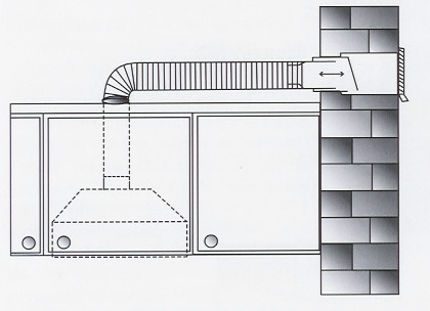
For example, the ventilation duct of the supply and exhaust air exchange available in the wall of a house is more than 150 m3/ h of air he is not able to remove.
Firstly, the cross section of such ventilation ducts does not exceed 130-140 mm, which is not enough for mechanical ventilation. Secondly, regular channel ventilation in high-rise buildings is extensive and contains multiple irregularities.
In the instructions for the ventilation unit, a diagram is usually indicated showing the relationship between the pressure in the ventilation duct and productivity. The increase in pressure causes a decrease in the performance of the hood.
The ventilation ducts in the houses are clumsy: uneven walls; streaks of solution; narrowing due to displaced blocks; many twists and turns. Or even - the ventilation shaft may be clogged. In such a situation, without cleaning is not enough.
Attempts to set the increased productivity of the ventilation umbrella connected to the house ventilation channel have the opposite effect.
The stronger the air flow, the more intensely it is prevented by defects in the cross section of the ventilation duct. And if actively injected air cannot move forward, it moves backward.
A simple example is a soccer ball. The more air to pump into such a ball, the more difficult it is to operate a pump. The pressure becomes an obstacle - there is a lot of air, he seeks to go back through the tube, pushing the handle of the pump.
A similar situation is with a hood with increased power - the more intensively the air is supplied, the more its operation is blocked.
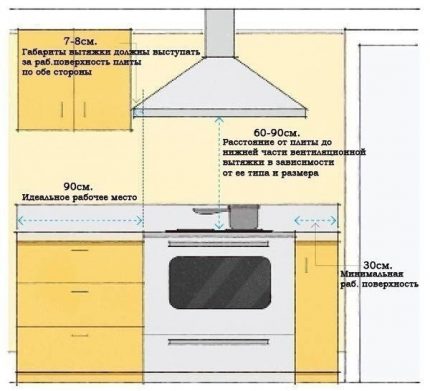
The ideal ventilation duct for a cooker hood is short, with a minimum of bends. Therefore, it is not necessary to remove air from the stove via the supply and exhaust channel, but according to the design made specifically for the exhaust hood.
Hole in the front wall, rigid or flexible duct (ideally circular) check valve and a lattice air intake at the outlet of the channel. So you should equip a cooker hood.
More arrangement exhaust valve through the wall We examined the street in our other article.
Conclusions and useful video on the topic
Power, brand, design and the principle of placing an hood hood - sellers of kitchen equipment salons colorfully talk about all this.
From the video below, you will learn about the nuances of choice that are not mentioned by sales staff. Models of hoods are distinguished not by design, but by the quality of assembly and configuration:
In the next video, the masters drill the walls in a high-rise building under the exhaust duct duct. Work is carried out by a professional tool quickly and accurately.
A ventilation duct is mounted to the prepared opening, which will be connected to the hood after finishing the kitchen:
Most videos on household exhaust hoods contain either promotional or simplified information of their choice. Moreover, the procedure for calculating the power is not given anywhere else - it is entirely “kitchen volumes” and “10-fold atmospheric updates”.
We are sure that balancing the home atmosphere can be the only way - the correct calculation of air cleaning equipment.
Does your cooker hood do a good job of removing exhaust air? Share your power calculation experience. Or maybe you used a simpler method instead of formulas and complex calculations? Tell us about it - leave your comments in the block below.

 Calorifier calculation: how to calculate the power of a device for heating air for heating
Calorifier calculation: how to calculate the power of a device for heating air for heating 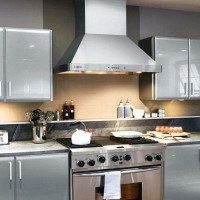 Ventilation in houses with gas stoves: rules and regulations in the organization of stable air exchange
Ventilation in houses with gas stoves: rules and regulations in the organization of stable air exchange 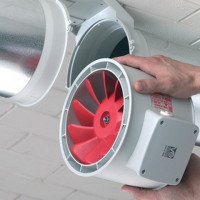 How to determine fan pressure: ways to measure and calculate the pressure in the ventilation system
How to determine fan pressure: ways to measure and calculate the pressure in the ventilation system  How to make a ventilation calculation: formulas and an example of calculating a supply and exhaust system
How to make a ventilation calculation: formulas and an example of calculating a supply and exhaust system  Cottage ventilation: options for organizing an air exchange system + device rules
Cottage ventilation: options for organizing an air exchange system + device rules 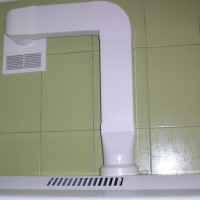 Ventilation plastic pipes for hoods: the nuances of selection and installation
Ventilation plastic pipes for hoods: the nuances of selection and installation  How much does it cost to connect gas to a private house: the price of organizing gas supply
How much does it cost to connect gas to a private house: the price of organizing gas supply  The best washing machines with dryer: model rating and customer tips
The best washing machines with dryer: model rating and customer tips  What is the color temperature of light and the nuances of choosing the temperature of the lamps to suit your needs
What is the color temperature of light and the nuances of choosing the temperature of the lamps to suit your needs  Replacement of a geyser in an apartment: replacement paperwork + basic norms and requirements
Replacement of a geyser in an apartment: replacement paperwork + basic norms and requirements
Sellers of cooker hoods, in my experience, say anything to sell a cooker hood. They will list a bunch of advantages and benefits, but they will never say something the opposite, some negative consequences, so yes, this is a problem. Especially in Khrushchev. True, I was lucky, when I turned on the hood, I turned to a specialist who knew a lot about all this and successfully selected the best option for me, but this is an exception, as a rule, people put what sellers put in to them.
Here I completely agree with the comment above. The hood should be in the kitchen, not only because the rooms did not smell like food! I would not even have thought of connecting an exhaust hood with a ventilation outlet, because it is not intended for this. And not to sellers of equipment then live in this apartment. You need to know the standards and be guided by them, and not by information that is not verified.
The article is excellent, but unfortunately, with an insulting error that is confusing. The illustrations are confused: the 1st illustration in the section “Stage # 2 - calculation of the hydraulic diameter and flow rate” should be instead of the 1st in the section “Feature of the kitchen hood”, which indicates the parameters “A” and “B” from the calculation formula.And it so happened that the section for calculating the performance of the hood provides a formula that is refuted at the beginning of the article.
Yes, you're right, thanks. Corrected.
Early praised you for the article. In it, you refer to your other article, “The installation height of the hood ...” where you can find a table with recommendations for selecting performance depending on the area of the kitchen ... We arrived ... It seems that you want to please everyone.
Lki = 5 · 10-3 * 1037.51 / 3 * (0.75 + 1.7 * 0.6) 5/3 * 0.75 = 0.061 m3 / s - counted several times - all the time it turns out 0.0983 . How did 0.061 come about? Teach.
How, when translating from cubic meters per second, we multiplied by a meter and received a cubic meter per hour? Why in the formula D / L? It is written that r is from the table above, but I don’t see the table, and yes the answer doesn’t agree either.
Hello, I need advice on selecting a section of a rectangular plastic channel for a kitchen hood with a capacity of 400 m3 (output round L = 120 mm). The channel length is 4.5m and 4 rotation angles. Will the section fit 120x60 mm or do I need 204x60 mm?
Good afternoon, Vladimir Viktorovich.
The equivalent diameter of a rectangular duct, denoted in the calculation of De, is determined as follows:
De = (1.3 × (a × b) × 0.625) / (a + b) × 0.25.
Here “a” and “b” are the sides of the rectangular duct. All values are in millimeters.
For a channel of 120x60 millimeters, we get:
De = (1.3 × (120 × 60) × 0.625) / (120 + 60) × 0.25 = 130 (millimeters).
By the equivalent diameter, this ventilation duct passes, and 204 × 60 will be redundant.
The site has an article "Calculation of the area of ducts and fittings», Which will be useful for you to take into account the remaining features of your exhaust system.
Dear you, the area of the outlet is approximately 11310, and the wind channel 120h60-7200. So, with your calculations, you get a blockage (channel throughput diameter is lower than the output). But 204x60 approximately corresponds to the face value of the exhaust outlet, so do not fool people with their heads.
204x60 will do, arithmetic is simple